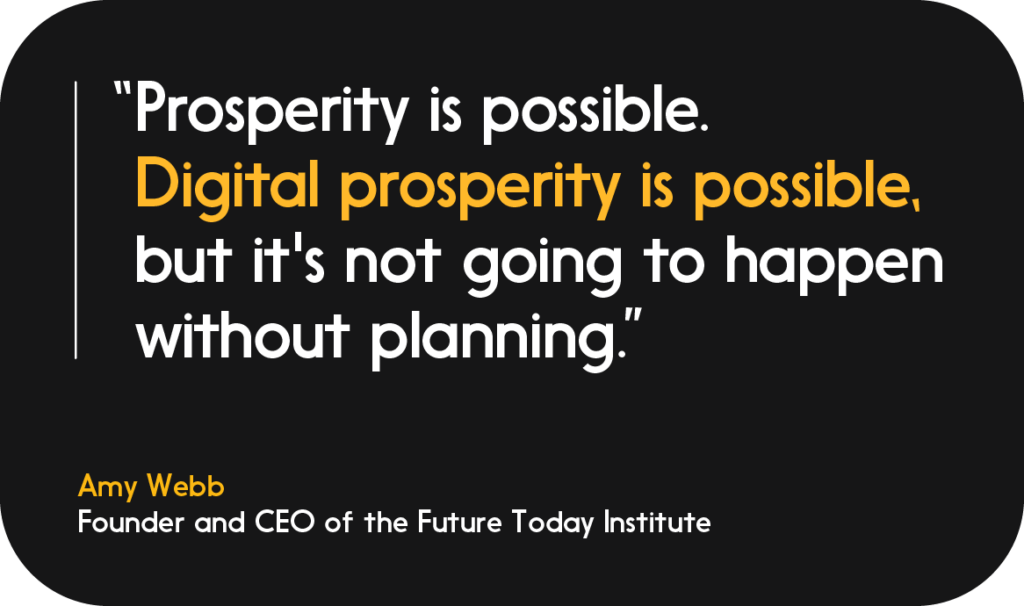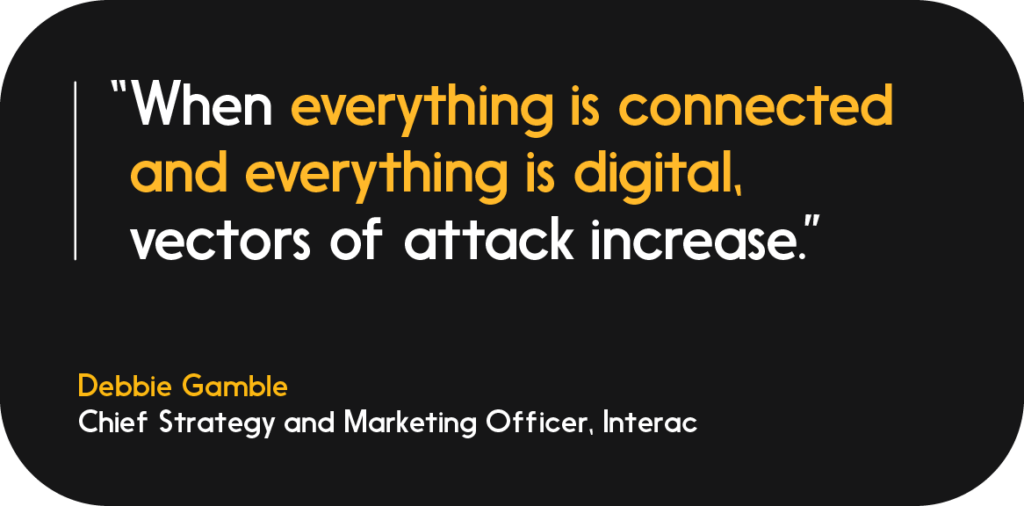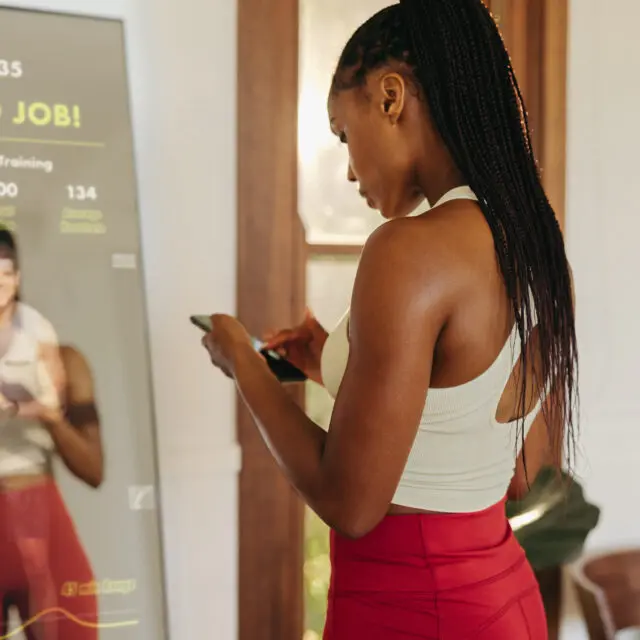Are we living through a “technology supercycle”?
My guest in this episode of Everyday Trust defines a technology supercycle as a disruption on the same scale as the Industrial Revolution or the advent of the internet, and with the same fearsome and exciting potential for reshaping society. This time, according to Amy Webb, it’s not one technology that’s changing how we live, work and think. It’s a confluence of three: artificial intelligence; the internet of things, including wearable devices; and advances in biotechnology.
What these technologies have in common — beyond the fact that they’re all rapidly emerging at the same time — is that they create value through the collection and harnessing of data. That’s the subject of this episode of Everyday Trust, my series of conversations with leading thinkers about the role of trust in a rapidly changing technology landscape.
And in keeping with our theme, we’re also focusing on the role of trust and how it could be the essential ingredient in crafting a data-sharing future that builds prosperity for everyone, rather than dividing us into digital haves and have-nots. To achieve this, we’re going to have to overcome challenges, including the increased threat of fraud that these emerging technologies create, and the fact that Canadians are already deeply concerned about the privacy and security of their data.
Let’s start by looking at possible futures for data sharing.
The opportunity: Using data to create value
Amy and I presented our audience with two possible visions for a data-sharing future.
(And before we go on, here’s a little more about Amy: She’s the founder and CEO of the Future Today Institute [FTI], where she and her team have developed a powerful data-driven foresight methodology to try to make sense of our future — including our digital future, and what we need to do to navigate emerging technologies.)
Our first chilling scenario was one of a sharp divide between haves and have-nots, where lower-income people would be essentially obligated to share their data in exchange for the essentials of life — imagine, for example, a grocery store where lower-income people watch advertisements in exchange for discounts (while their wearable devices track them to make sure they’re paying attention). Rather than something to enjoy, the wearable device becomes almost like a yoke. Richer patrons, meanwhile, wouldn’t need a discount — they could just ignore the prompts and coast through. “We’re headed toward a future where smart glasses … are going to enable different types of pricing, different types of financial transactions, and I think that will probably lead to a new and worse digital divide,” Amy said.
Thankfully, we can also imagine much brighter possibilities for data sharing. For example, one in which data sharing could be a source of income for people — for example, if social media users were compensated for opting to share their data with the platform.

Or more ambitious still, how about a world in which patients opt in to share their medical data, which would be anonymized and used in the fight against cancer? “What we’re talking about is using data in these different ways to create value,” Amy said. For business leaders and citizens who want to ensure we choose the right path forward, there are key questions to grapple with; we’ll look at a few below. We also talk about why, as Amy put it, “verification is going to be mission critical” for making sure the Canadian economy reaps the benefits of a data-driven world while avoiding the pitfalls.
Data and value creation: A few of the big questions
1. How can we guard against fraud in an age of data and deepfakes?
At Interac, we’re used to thinking about fraud and staying one step ahead of fraudsters — working to safeguard Canadians against fraud is one of our most important activities. As the pace of technological development accelerates, it creates opportunities for bad actors, and the work becomes more challenging. When everything is connected and everything is digital, vectors of attack increase.
Amy and I discussed how “deepfake” videos are already deceiving people, including workers in the financial sector. And as Amy points out, as powerful as a lot of this technology seems to us today, it will continue to evolve. “What comes after large language models are large action models,” she said. If you thought deepfaked videos were challenging to guard against from a fraud perspective, just wait for deepfaked events. Where can we look for solutions? Amy and I talk about one major avenue, digital verification, in the next section.

2. How can digital verification help consumers trust their transactions?
As part of our goal of keeping Canadians secure, we at Interac have been very focused on how to help consumers and businesses safeguard their transactions and digital engagements. Verification solutions can help keep Canadians secure even as technology gallops ahead. That’s why we see it as a necessity for a vibrant digital economy.
Amy used the example of food fraud, which is a problem in Canada because there are financial incentives to deceive the public (it happens when fish are labelled with the wrong species, for example). She suggested that some form of digital verification solution could allow a consumer to verify “not just where [a] product was manufactured, but trace where all of the ingredients came from.” We could imagine a myriad of other ways that digital verification could help restore and maintain trust in our interactions, even as technology forges ahead. As Amy said, “We’re always asking the question, ‘What does value creation look like in the future?’ And obviously, trust and accountability is a huge piece of that.” In order to create value through data, “you need a trusted intermediary,” she said, adding. “which is literally what Interac is.”
3. How does the technology supercycle change how business leaders need to think?
From fraud attempts disguised as hyper-realistic videos to devices that mine our data around the clock, scenarios that would have looked like science fiction just a few years ago are now on the table. For better or worse, the future has arrived.
Business leaders’ long-term strategic thinking — what Amy calls “corporate foresight” — has to be nimble and creative enough to encompass and anticipate the ramifications of these technologies. “When you’re thinking about the future, you have to break free of your typical patterns,” Amy said.
“We often assume that the future will be like [the present] but worse, or that the future can be like [the present] but better. “We don’t often think about the future just being different than today.”
4. What can Canada do to lead in a time of technological change — rather than get left behind?
We’ve talked about how this technology supercycle could create winners and losers — and how it has the potential to positively shape a country’s GDP and serve as a catalyst for value creation.
I think the “right” future is one that creates what I would call “inclusive value” — a data-sharing future that creates prosperity for everyone. At Interac, we’ve already long been grappling with how to broaden access, broaden competitiveness, and help Canadians embrace this digital future. I think this prosperous digital future is something worth fighting for, and we’re going to have to get our act together if we actually want to have it.
“For companies and countries that aren’t preparing for it, or are preparing for the wrong type of future, this could really threaten the economy and the future prosperity of those people,” Amy said. “Digital prosperity is possible, but it’s not going to happen without planning.” Personally, I think the Canadian ecosystem is more than capable of achieving these goals. And we’re at our best when we take a collaborative approach and work together toward solutions that are equitable and sustainable.
Watch the full conversation with Debbie and Amy
In the full video, Amy and I talk about other ways emerging data-driven technologies intersect with trust and verification, including the privacy implications of wearables and the potential GDP boost to the Canadian economy from digital verification.




